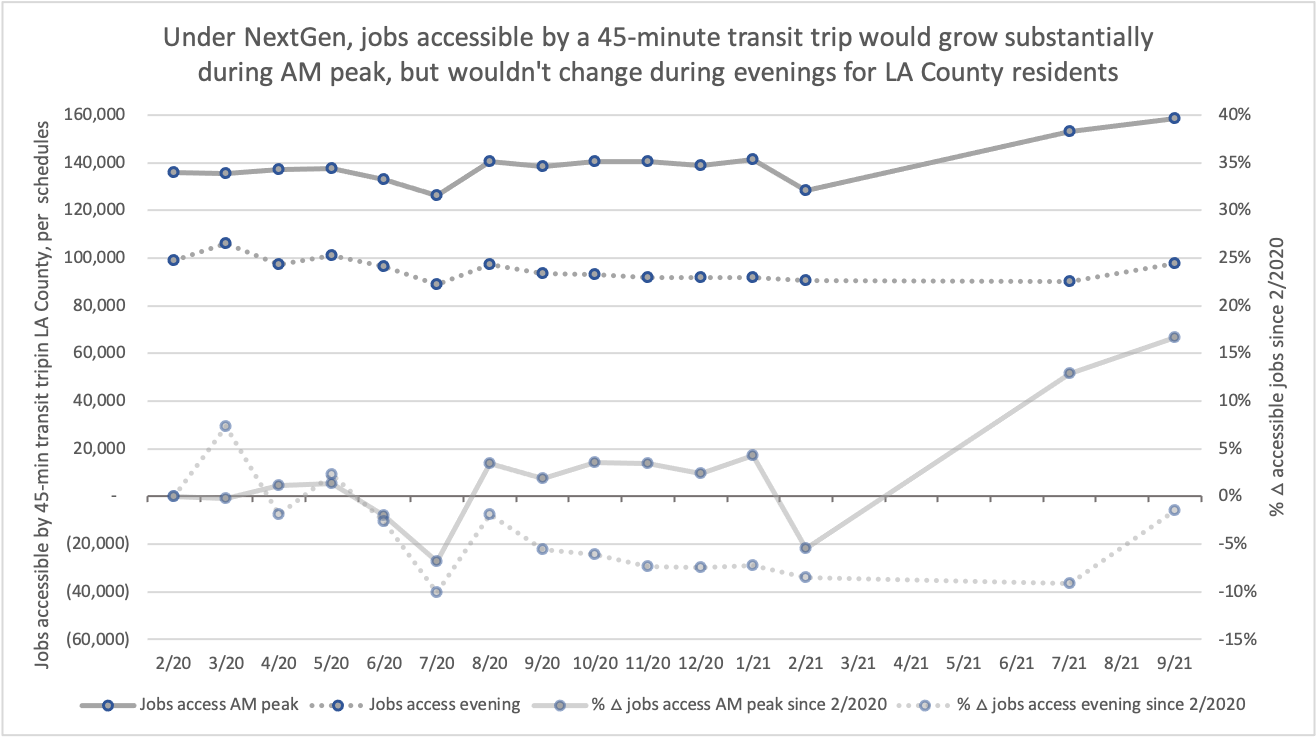
Photo via Investing in Place
LA Metro recently implemented its NextGen Bus Plan, a long-awaited network redesign that Metro promised would “provide fast, frequent, reliable and accessible service to meet the needs of today’s riders.”
Metro introduced NextGen’s schedule and route changes to the bus network over three “shake-ups” in June, September, and December 2021. The changes were supposed to restore bus service to its pre-Covid level. But since the fall, extreme operator shortfalls have forced Metro to cancel scheduled trips regularly, depriving riders of promised service or a shred of reliability. Cancellations peaked in January when almost one in five scheduled buses didn’t show; half of trips on the high-ridership 754 route were canceled. In February, Metro cut bus service by 12%, recognizing that the shortfall of drivers left it unable to provide its new and improved NextGen network.
These disruptions mean that for Angelenos, bus service on the ground is profoundly different (and worse) than what NextGen had laid out. So, what are bus riders missing out on? We used the TransitCenter Equity Dashboard to see how planned transit service changes introduced by NextGen would have affected transit riders’ ability to get around if successfully implemented. We compared access to destinations by transit, based on schedules before NextGen (February 2021) and after the first two NextGen shake-ups (July and September 2021).
Note: our analysis includes service provided by other regional agencies, such as Long Beach Transit and LA DOT. LA Metro is the region’s largest transit provider and its service levels are weighted heaviest in the data. Changes in access to destinations by transit discussed below are predominantly, but not wholly, attributed to LA Metro service changes including NextGen.
It’s crucial to reiterate that the below analysis is based on scheduled service, not delivered service – the service Metro actually ran.
We found that if LA Metro were able to fully implement the new NextGen bus network, transit riders across Los Angeles County would gain substantial access to essential destinations. Jobs, healthcare, and other places would become easier than ever to reach by public transit, even surpassing the pre-Covid-19 benchmark. NextGen service changes would also lessen historic transportation inequities, improving access the most for Black and Hispanic Angelenos, and for residents of historically disenfranchised, disinvested communities.
On average, LA County residents would be able to take transit to an additional 30,000 jobs – an increase of over 20% – within 45 minutes based on September 2021 schedules compared to February 2021 schedules. The level of jobs accessible under September 2021 transit schedules was even higher than in February 2020, before the onset of the pandemic and the severe service cuts it triggered.
The NextGen Bus Plan would help Metro hold the promise of its Equity Platform to ensure the highest level of access for people of color and communities where it has identified the greatest need.
Our analysis found that transit access to jobs would increase substantially more for Black people than for other Angelenos. Based on February and September 2021 schedules, Black people would gain access to nearly 48,000 additional jobs in 45 minutes by transit, a 36% increase (compared to an additional 30,000 jobs for the average person). Residents of LA Metro’s Equity Focus Communities (identified by the agency based on demographic determinants of disinvestment and disenfranchisement) would be able to access 64,000 additional jobs, a 25% increase.
Under September 2021 transit schedules, residents of Equity Focus Communities would have the best access to jobs, hospitals, and colleges. Black and Hispanic people would have better access than the average.
Communities of color in South and Central LA would stand to gain substantial access based on NextGen’s service changes. For example, people living in parts of Compton, Crenshaw, Hawthorne, Inglewood, Watts, Westmont, and Willowbrook would experience a doubling of jobs accessible in 45 minutes during peak morning hours.
Below: Change in jobs accessible by a 45-minute transit trip in AM peak, comparing February to September 2021 schedules
Below: Change in jobs accessible by 45-minute transit trip in AM peak, comparing February to September 2021 schedules in LA Metro Equity Focus Communities
For some residents of Compton, Inglewood, Watts, Westmont, and Willowbrook, hospital trip times would shrink by more than 5 minutes.
Below: Change in transit trip times to the nearest hospital in AM peak, comparing February to September 2021 schedules
Below: Change in transit trip times to the nearest hospital in AM peak, comparing February to September 2021 schedules in LA Metro Equity Focus Communities
Given Metro’s operational challenges, scheduled access to opportunity is far better than what riders are actually experiencing on the ground in LA right now. For example, residents of South LA should have gained access to about 40% more jobs based on 2021 scheduled transit service. Instead, they suffered through the least reliable service in the county in early 2022, with 22% of bus trips canceled in January. This cruel reversal of fortunes no doubt hobbled the ability of bus riders to travel in and out of South LA for work, appointments, and other travel even as Metro schedules showed better service than ever.
NextGen has its limitations. Because the plan redistributed bus service hours rather than increasing them, Metro estimates that 0.3% of riders would lose access to transit near their home. Despite coordinated advocacy from local groups like Investing in Place, ACT LA, and Move LA, NextGen does not substantially increase bus frequency or make taking transit as efficient and reliable as driving. And based on September 2021 schedules, the average LA County resident could still reach an astounding 17 times more jobs in 45 minutes by car than by transit.
Nevertheless, it’s a good redesign that deserves to see the light of day. Metro must fulfill its promise to riders for better service by applying the necessary urgency and resources to address the operator shortfall (which we will explore further in an upcoming post).






